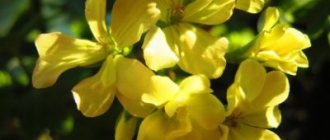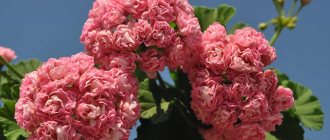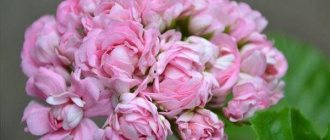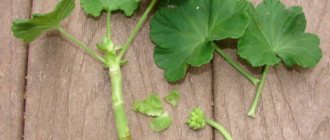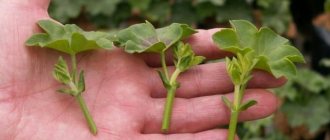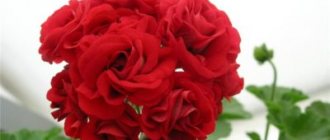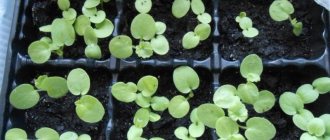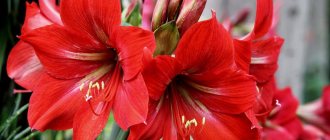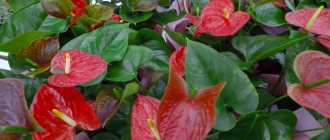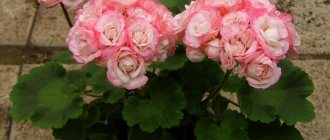The genus Pelargonium includes more than 300 plant species and is part of the Geraniaceae family. In the process of long-term cultivation using interspecific hybridization, many varieties have been created, and now it is not always possible to determine whether a plant belongs to a specific species or is of hybrid origin.
|
Most species of pelargonium are native to South Africa, Australia and New Zealand.
Plants of this genus are low-growing shrubs, subshrubs, as well as tuberous perennials and annuals. The stems are straight or creeping, branched, in some species thickened, succulent, which contributes to drought resistance. The leaves are usually alternate, pinnate or palmate-lobed, sometimes simple, often on long petioles, with stipules. Some species have a thick cuticle that helps them survive drought, while others have a distinct tonal pattern on their leaves. Flowers with five petals (in the original species) are collected in umbrella-shaped inflorescences. The fruits of pelargoniums resemble the head of a stork in shape (pelargos in Greek - stork), hence the name of the genus.
Pelargonium leaves contain an essential oil called geranium, which is widely used in perfumery and aromatherapy.
Read more in the articles Fragrant and healthy pelargoniums, Geranium essential oil.
Pelargoniums are often called geraniums, although geranium (Geranium) is an independent genus of the same family. But based on the structure of the flower, it is quite easy to distinguish these two genera. Pelargonium flowers are zygomorphic, have only one axis of symmetry, the petals differ in size and shape (usually the two upper petals are larger than the three lower ones). In true geraniums, the flower is actinomorphic, has radial symmetry, the line of symmetry can be drawn between any of the 5 petals, all petals are of the same shape. Pelargoniums have 7 anthers (stamens) in a flower, while geraniums have 10.
|
|
Pelargonium has become widespread as a houseplant. Despite its intolerance to even slight frosts, it is also successfully grown in balcony boxes, flower beds and flower beds as an annual or container crop.
The cultivation of pelargoniums began in the middle of the 17th century, and in the 20th century the number of varieties exceeded 9000. New varieties were selected as natural mutations of already created varieties, as well as through intervarietal and interspecific crossings.
Pelargoniums were originally divided into four main groups: zonal, ivy-leaved, royal and fragrant. As new cultivars accumulated, further division occurred in these groups (mainly affecting the group of zonal pelargoniums), and new groups of varieties appeared. A modern classification developed for exhibitions will help you navigate such a number of varieties.
Features of the view
The height of dwarf geranium ranges from 12.5–20 cm. This variety belongs to the beautifully flowering type.
Thanks to the efforts of breeders, there are many varieties with a wide variety of petal colors. Flowering is usually long and lush. Most often, dwarf pelargonium does not need shaping pruning, since it forms a neat bush on its own - this is very convenient for busy owners. However, please note: contrary to popular misconception, this property is not inherent in all dwarf varieties.
This plant looks stylish and noble both in an apartment and in an office interior. Well suited for landscaping balconies and verandas.
The best varieties
Let's look at the most popular varieties of dwarf pelargonium.
- Pink Ice. The bush is branched, strong and dense. Double flowers. The petals are quite long, soft pink in color, with a gradual lightening towards the edge. Cases have been recorded when one red flower could appear among the pink ones. Pink Ice is similar in many ways to the Natalie variety, but unlike it does not cause any problems with shaping. May be a little littered with petals.
- Jinky. The flowers are large, double, and form lush caps. The petals are pinkish-peach, sometimes with a cream tint. Closer to the core the color is especially rich. Flowering is long and abundant. The bush is airy and neat. The leaves are golden-green, often with an inner dark circle, giving them a special decorative appearance. Resistant to yellowing.
- Madame Salleron. This variety is valued primarily for its decorative gray-green leaves with a wide creamy-white border. The petioles are thin. The bush is very lush and does not emit the characteristic smell of geraniums. It blooms extremely rarely, with simple bright pink flowers. Bred in 1877
- Silk Moira. The inflorescences are dense, densely double, forming caps. The petals can be apricot or pale salmon. The top ones are usually a little darker. The leaves are golden green. The bush is compact, with short internodes, and grows quickly. Zoning on the leaves is weakly expressed, but in bright sun it can become noticeable.
- Clatterbridge. Pelargonium is a zonal type with a fluffy and dense bush. The flowers are densely double, fiery scarlet, and do not litter with petals. Collected in caps 9–10 cm in diameter. In bright sunshine, the petals acquire a crimson hue over time. Flowering is abundant and long. The leaves are small, the internodes are short.
- Pac Harmony. The flowers are semi-double, quite large (from 5 cm), juicy dark pink, lighter near the core. Owners of this flower unanimously note the early and extremely abundant and long “uncontrollable” flowering. Even a young bush quickly grows a large number of large inflorescences. The variety readily bushes and grows wider than tall. The foliage is scalloped and attractive.
- Deacon Suntan. The flowers are semi-double, bright orange, with a lighter underside and a white center. Collected in dense inflorescences, almost the size of a palm. The caps look especially large compared to the compact bush - according to reviews, sometimes they can even outweigh, causing the pot to fall. Flowering is long. The plant begins to throw out inflorescences at a young age. The shoots grow slowly, the bush sometimes remains at the miniature level (less than 12.5 cm), and not dwarf.
- Dylan Cherone. The flowers are speckled, double, with a pink or lilac-white background and burgundy markings. With plenty of light and fresh air, the shades become more saturated and the specks become brighter. Flowering is abundant, flower stalks are formed from almost every leaf axil.
- Marie Louise. The variety is distinguished by the unusual shape of the flowers: they do not open completely, which is why they resemble tulips. The decorative effect of the flowers is enhanced by the wavy edge. The petals are light peach with a transition to cream, sometimes salmon. There is a light border. The bush grows quite slowly.
- Diana Palmer. Geranium of zonal type. The flowers are semi-double, pastel orange, shaped like carnations. Quite large (4–4.5 cm). Flowering begins early, sometimes barely rooted cuttings are already forming buds. The variety does not bush on its own and requires pinching. The bush is relatively large. Leaves stop growing after flowering begins.
Varieties of indoor plants with names and what they look like
Breeders have developed a whole group of varieties of this pelargonium. Each of them has certain advantages.
PAC Viva Madeleine
This plant variety is considered the most compact. Pelargonium Viva Madelina is characterized by dark green leaves. The shrub has neat outlines.
Flowering is typical. Pelargonium Madeline is characterized by white inflorescences with a slight pink color.
PAC Viva Carolina
The plant has large buds. They are characterized by a combination of white and lilac shades. The inflorescences have a fleecy texture. Each umbrella contains 5-6 flowers. The leaves are characterized by a typical bright green color.
PAC Viva Rosita
This culture is characterized by deep pink or coral petals. Geranium foliage has a lighter shade. A distinctive feature of the culture is considered to be lush and abundant flowering. Each inflorescence contains 5-7 buds. When they bloom, the culture looks truly luxurious.
PAC Viva Maria
A distinctive feature of the plant is the unusual color of the buds. It is characterized by a combination of white and pink tones. The white color is at the base of the petals; towards the middle it turns pink. The leaves are medium in size and rich green in color.
Important! Flowering lasts 15 days, during which the buds retain a rich shade. At the same time, the plant looks quite neat
The color of the buds depends on the plant variety
Growing rules
In order for geranium to delight with lush, abundant flowering, it is important to create comfortable conditions for it.
Like other varieties, dwarf pelargonium needs plenty of light: without it, the foliage and flowers turn pale, the sprouts become disproportionately elongated, and the leaves become smaller. The optimal place for growing will be a south window. It is desirable that the light be diffused, but direct sunlight for several hours a day is also allowed. However, if the leaves begin to turn yellow and dry, the flower needs to be moved to more gentle conditions. In winter, additional lighting is desirable: the optimal daylight hours for this plant is 16 hours.
Description and characteristics of cultivation
Interestingly, among all the variety of varieties, it is dwarf geranium that is becoming increasingly popular. It has many advantages. For example, such a plant will take its rightful place on the windowsill and fit perfectly into any of your flower collections.
It is grown in a compact pot, since the flower is very miniature. Nevertheless, its small dimensions do not prevent it from blooming magnificently. Another important advantage of this group of geraniums is that formative pruning of such a flower specimen is not necessary at all.
Caring for dwarf pelargonium varieties at home is not too labor-intensive; even a beginner can handle it. However, take some recommendations into account so as not to harm your indoor flowers. For example, like most geraniums, dwarf pelargonium does not like waterlogged soil - it will cause the rhizome to rot before you even blink an eye. That's why remember two things:
- The plant substrate should be moistened in moderation;
- The soil must contain sand or vermiculite. Such components are useful because they absorb excess moisture, and you do not have to correct the consequences of waterlogging the soil.
You will certainly be able to care for low-growing varieties of pelargonium. Over time, many gardeners begin to expand their collection of dwarf geraniums. This can be done easily and at home, no extra costs will be required.
How are these flowers propagated? It is best to start this procedure at the end of February or early March. It is during this period that the plant gradually comes to its senses after wintering, and its vital processes are activated. First of all, cut the cutting with two internodes, and then dry it thoroughly.
The next stage is planting in nutrient soil. It is not recommended to cover the top of the cutting with glass or film - this will only create an excessively humid environment for the geranium, which can have a detrimental effect on it. Miniature cuttings of pelargonium will very quickly take root in a new place. The main thing is to place the pot with the shoots in a well-lit place. Under favorable conditions, within a month you will receive a fully rooted plant.
Of course, you can’t do without transplanting homemade miniature geraniums. This procedure is not performed very often. If you notice that the flower has grown sufficiently, and, most likely, there is no longer enough space for the rhizome in the mini-pot, you can place it in a slightly larger pot. But don’t overdo it: if you plant a plant in a flowerpot that is too large, it may simply die, because the root system will not fill the bottom of the container, and without this the flower will not begin to develop.
In order for pelargonium varieties Dovepoint or pelargonium Barnstondale to delight you with its lush and long-lasting flowering, you need to take care of this yourself. You can't do without feeding. Nutrient mixtures can be added to the substrate a month after planting the plant in its permanent place.
Purchase either universal nutritional formulations or special fertilizers for homemade geraniums. You should not neglect feeding the flowers, since if there is a deficiency of organic and mineral substances in the soil, the plant may suffer from chlorosis or blackleg (fungal disease).
The best varieties
There are more and more new varieties of pelargonium. That is why it is worth considering the most remarkable specimens. Only this way can you make an informed choice and purchase plants that will certainly decorate your home. Among the popular dwarf species of pelargonium, the following varieties are distinguished:
- pelargonium variety Jinky. The advantage of this plant is considered to be large double flowers of a light creamy color. At the same time, at the very core, the petals acquire a rich pink color. This plant is very tender and airy, its foliage is characterized by the presence of a light green tint;
- pelargonium variety Pink Ice. This dwarf bush is quite stocky and branchy for its small size. Its petals are elongated, double, and have a soft pink tint;
- pelargonium variety Clatterbridge. This plant belongs to the group of zonal dwarf geraniums. This shrub is also miniature in size, but blooms intensely. Its flowers are double, bright red;
- Silk Moira. This pelargonium has salmon-colored flowers. This plant is not picky in its care, and it is not difficult to form;
Appearance
The main distinguishing feature of this variety of pelargonium is its graceful, unevenly colored leaves. It is because of the foliage, and not because of the flowers, that in this case the plant is bred. The following shades predominate in foliage color :
- green;
- emerald;
- burgundy;
- purple;
- plum;
- bronze.
According to the color of the foliage, variegated pelargoniums are divided into two subgroups:
- yellow-golden , in which the main color of the leaves is yellow;
- silver , in which the main color can be any, but there is one distinctive feature - a cream-colored canvas around the edge.
The predominant pattern on the leaves is a butterfly, and it is always darker than the main shade. The number of shades mixed in one sheet is usually two, sometimes three.
Grow lush beauty at home - dwarf pelargonium!
Dwarf pelargonium is gaining the attention of gardeners every day. Such wide demand is due to the plant’s unpretentiousness in care.
Due to its compact size, the flower does not take up much space on the windowsill. In addition, dwarf pelargonium blooms profusely.
This article describes in detail how to properly care for dwarf pelargonium, what diseases and pests can attack the flower. You will also learn how to properly propagate this beautiful plant.
Planting in open ground and subsequent care
The soil in the area allocated for planting is dug up using a spade and thoroughly loosened with a rake, after which compost is spread over the surface. This fertilizer is carefully mixed with the top soil layer using a rake.
Planting holes should contain a depth of 20 cm. Small varieties should be planted at a distance of 15–20 cm from one another, and large varieties should be planted at a distance of 50 cm. When transplanting, it is necessary to carefully remove the root system of the seedlings from the container, then water the plants, and if necessary, protect from direct sunlight for seven days.
Caring for garden pelargonium consists of systematic watering with warm water, loosening and fertilizing. Special complex fertilizers for flowering plants are applied every 14 days. A positive result is achieved by using the Dutch fertilizer “Kristalon” for this purpose.
Pelargonium is an undemanding plant that produces attractive flowers. To maintain lush and long-lasting flowering, it is enough to follow simple rules for planting and growing this decorative perennial crop.
Common varieties and photos
You can purchase dwarf pelargonium of the following types, look at the photo.
Jinky
The advantage of the variety is large double flowers of light creamy color . At the very core the petals are deep pink. The plant itself is tender and airy, the leaves are light green in color.
Pink Ice
It is a mini bush that is stocky and branchy despite its compact size. The petals are elongated, terry, and pale pink in color.
Read more about Pink pelargonium and its varieties in this material.
Clatterbridge
This decorative crop belongs to the group of zonal dwarf pelargoniums. The peculiarity of the variety is its intense flowering . The buds are terry type and bright red in color.
Silk Moira
The variety is distinguished by salmon-colored petals. It is not picky in care, and the process of forming a bush also does not require much effort.
You can learn more about Pelargonium Silk and its species - Moira, Laguna, Aurora and others, as well as see photos of flowers here.
Madame Maleron
This variety does not bloom at all, but its main advantage is its dark green leaves with a light edge.
Description of the pelargonium variety Dovepoint and its characteristics
The flower belongs to the Geraniaceae family. It includes more than 400 varieties of plants. The culture is characterized by very dense inflorescences. Geranium has gorgeous lush flowers that can change their color from white to light pink. The bushes are compact in size.
The flower is characterized by beautiful inflorescences of a soft pink hue.
For your information! The flower is characterized by abundant and long-lasting flowering.
History of origin
The plant got its name because of its resemblance to a crane's beak. The culture owes its origin to India and South Africa. It was from these places that the flower came to Europe. In Russia, culture became popular in the 19th century. Flowers were often grown to decorate parks.
Pelargonium Dovepoint is a zonal plant. The culture is very popular among flower growers. It has beautiful flowering and is undemanding to care.
Features of the variety
The description of Dovepoint pelargonium says that the plant is characterized by compact bushes and lush inflorescences. The petals can be white or pink. They form voluminous double flowers. The bushes are decorated with green leaves, which have a regular round shape.
The flowering of the crop continues in spring and summer. With adequate care, Powerpoint pelargonium can bloom for 6 months. If you provide the flower with additional lighting in autumn and winter, its flowering will last.
Important! If there are no flower stalks and the branches are stretched out, a lack of lighting can be suspected. If necessary, it is recommended to use phytolamps
The culture has beautiful bushes that are used to decorate rooms and areas
Winter hardiness
Indoor crops easily tolerate the winter period. It is recommended to reduce the number of waterings and the frequency of use of fertilizers.
Landing
In order for the plant to fully grow and develop, you need to know the main features of planting a crop :
- choice of location;
- illumination;
- temperature;
- soil composition.
Lighting and location
In order for the mini-bush to bloom for a long time and beautifully, carefully choose a well-lit place. With sufficient light, the plant will have bright not only petals, but also leaves. If there is a lack of light, the decorative appearance of the flower will fade : there will be fewer inflorescences, and the leaf blade will turn pale.
For the correct formation of the crown, the flower pot should be turned to the window in different directions. Then the sun's rays will be able to reach all parts of the plant, and it will begin to grow evenly.
Home care
Temperature
In summer, dwarf pelargonium prefers to grow in moderate temperatures - 17-23 degrees Celsius. Overheating must not be allowed. In winter, the optimal temperature remains 12-13 degrees, but not higher, since during this period the flower rests.
Watering
Dwarf pelargonium responds positively to soil moisture, so you need to water it regularly and abundantly. In summer, moisturizing is done every other day, and in winter – once a week. It is important to ensure that the soil dries thoroughly before watering .
Top dressing
The plant must be fed regularly, especially during the growing season - from March to November. In winter, the plant does not require additional nutrition, as it rests.
Phosphorus or potassium should be used as fertilizing , and it is important not to overdo it with nitrogen. If this element is in excess, the green mass will begin to grow actively, but flowers will not form. Complex fertilizers must be applied once every 2 weeks.
Molding
In order for the bush to be lush, it is necessary to regularly pinch out young shoots.
This manipulation will enable the plant to form a large number of lateral branches, as a result of which the decorative appearance of pelargonium will improve. Sometimes the shoots become very elongated during the winter, so in the spring they have to be removed by 1/3 of their growth. If the cuttings are healthy and strong, they can be rooted. Then there will be even more beautiful and graceful pelargoniums in the house.
Planting and further care
Plants are planted mainly using cuttings or seeds. The full development of the bush and gorgeous flowering depend on the choice of the optimal planting site, as well as on compliance with the rules of agricultural cultivation.
Selection and preparation of a site
Pelargonium is one of the plants that loves sunlight. Lack of lighting can have a detrimental effect on growth and flowering. If Dove Point pelargonium is grown on a plot, an open, sunny area is chosen for it. The soil for planting must be fertilized.
Planting pelargonium
How to plant
You can collect the seeds yourself or purchase them at the store. Their shell is quite dense, so it is recommended to first rub them with sandpaper. To quickly peck the sprouts, the seed material should be soaked between moistened layers of gauze or cloth.
Planting with cuttings is carried out immediately after pruning. Cut branches must be cleared of leaves and placed in water. After the roots have sprouted, the cuttings are planted on the plot or in a pot. Many gardeners prefer not to wait for the roots to appear, but plant the cuttings directly into the soil to a depth of 2-3 cm. Then watering must be carried out for several weeks.
Watering and fertilizing
The bushes must be watered regularly and in doses. Lack of moisture causes the plant to wither, yellowing and falling leaves. Excess water can lead to rotting of the root system. In summer, the watering procedure should be carried out at least once a week, in winter - once every two weeks.
Geranium bushes need to be fed in spring and summer. With the onset of cold weather, the activity of the flower ends and it is time to rest.
Note! It is not advisable to spray the plant. Blooming pelargonium Dovepoint does not need additional moisture
Water that gets on the leaves leaves unsightly stains.
Trimming
To form a beautiful and lush crown, it is important to carry out pruning in a timely manner. Dried flower stalks should be removed immediately
The procedure is carried out after the flowering period with a special garden tool. All shoots are shortened by approximately one third of the length. This helps side shoots grow. After pruning, cuttings can be used to propagate pelargonium.
Preparing for winter
Pelargonium is a perennial herbaceous shrub. When the flowering time is over, you need to trim the shoots and prepare the plant for wintering. To do this, place the container with pelargonium in a cool place (+10… +15 °C) with diffused light. A 12-hour daylight period is organized for the flower using special lamps.
Important! During the dormant period, you should not get too carried away with watering, and you also do not need to add nutritional supplements.
Diseases and pests
The most common pests that attack dwarf pelargonium remain:
To combat parasites, it is necessary to use the following drugs: Aktara, Confidor.
Dangerous diseases include:
- Black leg . This is root rot, which occurs as a result of excessive soil moisture and insufficiently high air temperatures. There is no cure for blackleg, so the affected plant must be disposed of immediately. The soil that remains in the pot must also be disposed of.
- Swelling and rotting of leaves . A pathological process occurs as a result of excessive watering. And at low temperatures the foliage begins to turn red. To prevent this, it is necessary to move the pot away from the window glass on frosty days.
- Stretching and exposing stems . Occurs as a result of lack of light. To solve this problem, you need to place the flower pot in a well-lit room. If there is no flowering, it is because the air temperature is too high during wintering.
